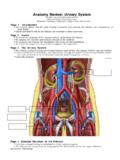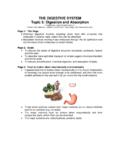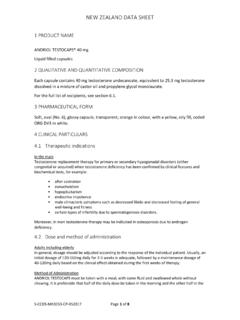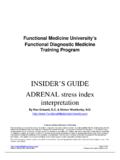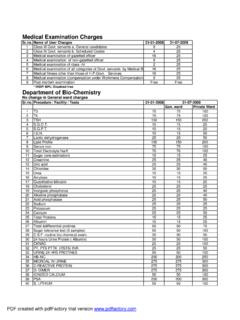Transcription of Endocrine System Review - interactivephysiology.com
1 Endocrine System Review Graphics are used with permission of: Pearson Education Inc., publishing as Benjamin Cummings ( ). Page 1. Endocrine System Review Consists of discrete individual glands that produce and secrete chemical messengers known as hormones. Hormones travel from Endocrine organs to their targets via the blood. Target cells are cells that have receptors for specific hormones on them. Page 2. Goals/ What You Need to Know Goals To identify the well established Endocrine glands in the body. To Review some of the well-understood hormones that are produced by each gland or tissue.
2 To identify some of the major target tissues for each gland or tissue. To understand a simplified function for each hormone that is reviewed. What You Need to Know The difference between Endocrine and exocrine glands and the composition of a mixed gland. The difference between Endocrine glands and Endocrine tissues. The basic categories of organic molecules. The components and functions of a negative feedback System . Page 3. Endocrine Glands: Hormones and Functions *Be sure to Review all the highlighted Endocrine glands on this page.
3 Pituitary gland Divided into the glandular anterior lobe and the neuronal posterior lobe. All six anterior pituitary hormones are peptides. The Six Major Anterior pituitary hormones are: 1. Thyroid Stimulating hormone (TSH or thyrotropin). 2. Follicle Stimulating hormone (FSH, a gonadotropin). 3. Luteinizing hormone (LH, a gonadotropin). 4. Adrenocorticotropic hormone (ACTH, or corticotropin). 5. Growth hormone (GH). 6. Prolactin (PRL). Targets and Functions of the Anterior Pituitary Hormones 1. TSH target thyroid gland and stimulates secretion of thyroid hormone (TH).
4 2. FSH targets follicles in the ovaries of females and stimulates growth of follicle and production of estrogen. In males it targets the testes and stimulates sperm cell production. 3. LH targets follicle, triggers ovulation and increases secretion of progesterone. In males it stimulates testosterone production. 4. ACTH targets the adrenal cortex and causes the secretion of glucocorticoids. 5. GH - targets most bodily tissues and stimulates metabolism and growth of those tissues. 6. PRL - targets the breasts in females.
5 Stimulates breast development and lactation. Role is uncertain in males. For each target gland/tissue here fill in the correct anterior pituitary hormone . Pineal Gland Produces the amine hormone melatonin. Functions not well understood in humans but thought to play a role in regulating light-dark cycles. Thyroid gland Produces two very different hormones. 1. Follicular cells produce the amine-based thyroid hormone (TH). 2. Parafollicular cells produce the peptide hormone calcitonin. Targets and functions of TH include: 1.
6 Regulate many metabolic functions. 2. Essential for normal growth. 3. Essential for the development of the nervous System . 4. Essential for nervous System function in adults. 5. Amplifies the effects of the sympathetic nervous System . Label this diagram with the correct functions of TH. Calcitonin helps regulate blood calcium levels by inhibiting osteoclast activity, thus preventing excessive resorption of bone. Parathyroid glands A cluster of small glands on the posterior of the thyroid gland. Secrete the peptide hormone parathyroid hormone (PTH).
7 PTH is secretion is stimulated by a drop in blood calcium levels. PTH targets the following tissues: Kidneys PTH causes direct reabsorption of calcium. Bone- PTH causes the resorption of bone. Gut PTH stimulates conversion of vitamin D to calcitrol, which regulates absorption of calcium by the intestines. Thymus Large at birth and increases in size until puberty. Decreases until unnoticeable in adults. Secretes the peptide hormones thymosin and thymopoietin. Function is poorly understood, but they play a role in the development of T-cell lymphocytes (hence the name).
8 Adrenal glands Small, paired glands that sit atop the kidneys. Composed of an outer epithelial cortex and inner neuronal medulla. Cortex secretes three classes of steroid hormones (mineralcorticoids, glucocorticoids, and androgens) and medulla secretes the catecholamines. There are three zones to the cortex: 1. Zona Glomerulosa secretes mineralcorticoids. 2. Zona Fasciulata secretes glucocorticoids and androgens. 3. Zona Reticularis secretes glucocorticoid and androgens. Important cortex hormones include: 1.
9 Aldosterone mineralcorticoid that causes the reabsorption of sodium and the secretion of potassium. 2. Cortisol glucocorticoid that regulates metabolism, regulates the immune System , and facilitates the stress response. 3. Androgens stimulates growth spurt early in puberty and controls female sex drive. Adrenal medulla secretes the catecholamines epinephrine and norepinephrine. Epinephrine is more abundant. Both hormones facilitate the sympathetic fight or flight response. Label the different regions of the adrenal cortex and medulla and indicate which hormones they produce.
10 Region hormone Produced Pancreas A larger mixed Endocrine /exocrine gland that lies posterior to the stomach. Secretes two major peptide hormones, insulin and glucagon. Islet cells contain _-cells the secrete insulin and _-cells that secrete glucagon. 1. Insulin Lowers blood glucose levels by stimulating glucose uptake by cells, glycogen synthesis by the liver and triglyceride synthesis by adipose cells. 2. Glucagon Stimulates the breakdown of glycogen by the liver and the synthesis of glucose and ketones, thereby raising blood glucose levels.
